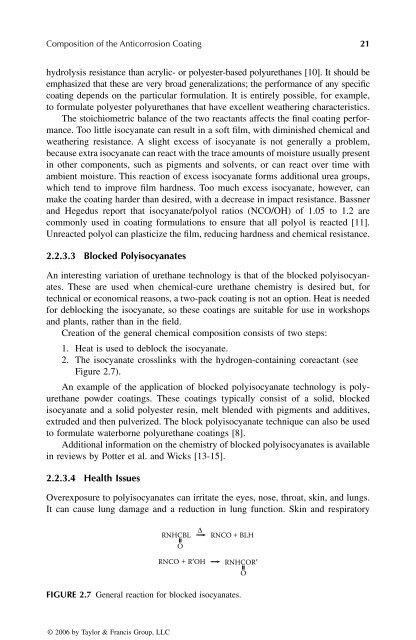© 2006 by Taylor & Francis Group, LLC
© 2006 by Taylor & Francis Group, LLC
© 2006 by Taylor & Francis Group, LLC
Create successful ePaper yourself
Turn your PDF publications into a flip-book with our unique Google optimized e-Paper software.
Composition of the Anticorrosion Coating 21<br />
hydrolysis resistance than acrylic- or polyester-based polyurethanes [10]. It should be<br />
emphasized that these are very broad generalizations; the performance of any specific<br />
coating depends on the particular formulation. It is entirely possible, for example,<br />
to formulate polyester polyurethanes that have excellent weathering characteristics.<br />
The stoichiometric balance of the two reactants affects the final coating performance.<br />
Too little isocyanate can result in a soft film, with diminished chemical and<br />
weathering resistance. A slight excess of isocyanate is not generally a problem,<br />
because extra isocyanate can react with the trace amounts of moisture usually present<br />
in other components, such as pigments and solvents, or can react over time with<br />
ambient moisture. This reaction of excess isocyanate forms additional urea groups,<br />
which tend to improve film hardness. Too much excess isocyanate, however, can<br />
make the coating harder than desired, with a decrease in impact resistance. Bassner<br />
and Hegedus report that isocyanate/polyol ratios (NCO/OH) of 1.05 to 1.2 are<br />
commonly used in coating formulations to ensure that all polyol is reacted [11].<br />
Unreacted polyol can plasticize the film, reducing hardness and chemical resistance.<br />
2.2.3.3 Blocked Polyisocyanates<br />
An interesting variation of urethane technology is that of the blocked polyisocyanates.<br />
These are used when chemical-cure urethane chemistry is desired but, for<br />
technical or economical reasons, a two-pack coating is not an option. Heat is needed<br />
for deblocking the isocyanate, so these coatings are suitable for use in workshops<br />
and plants, rather than in the field.<br />
Creation of the general chemical composition consists of two steps:<br />
1. Heat is used to deblock the isocyanate.<br />
2. The isocyanate crosslinks with the hydrogen-containing coreactant (see<br />
Figure 2.7).<br />
An example of the application of blocked polyisocyanate technology is polyurethane<br />
powder coatings. These coatings typically consist of a solid, blocked<br />
isocyanate and a solid polyester resin, melt blended with pigments and additives,<br />
extruded and then pulverized. The block polyisocyanate technique can also be used<br />
to formulate waterborne polyurethane coatings [8].<br />
Additional information on the chemistry of blocked polyisocyanates is available<br />
in reviews <strong>by</strong> Potter et al. and Wicks [13-15].<br />
2.2.3.4 Health Issues<br />
Overexposure to polyisocyanates can irritate the eyes, nose, throat, skin, and lungs.<br />
It can cause lung damage and a reduction in lung function. Skin and respiratory<br />
RNHCBL<br />
O<br />
RNCO + R′OH<br />
RNCO + BLH<br />
RNHCOR′<br />
O<br />
FIGURE 2.7 General reaction for blocked isocyanates.<br />
<strong>©</strong> <strong>2006</strong> <strong>by</strong> <strong>Taylor</strong> & <strong>Francis</strong> <strong>Group</strong>, <strong>LLC</strong><br />
∆
















